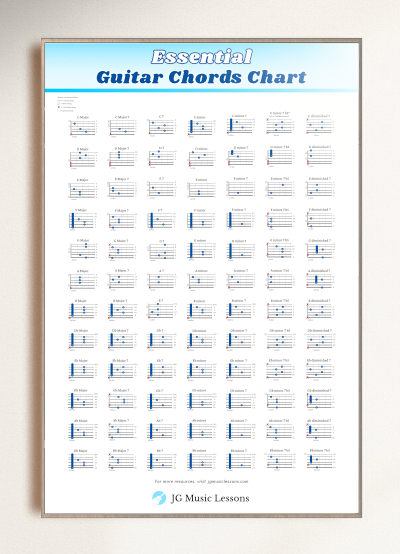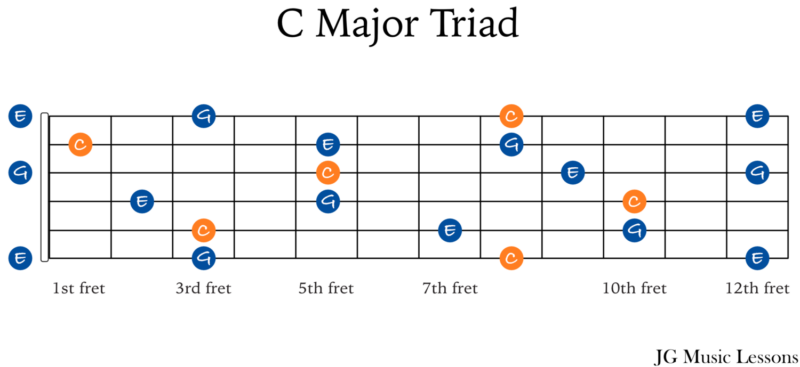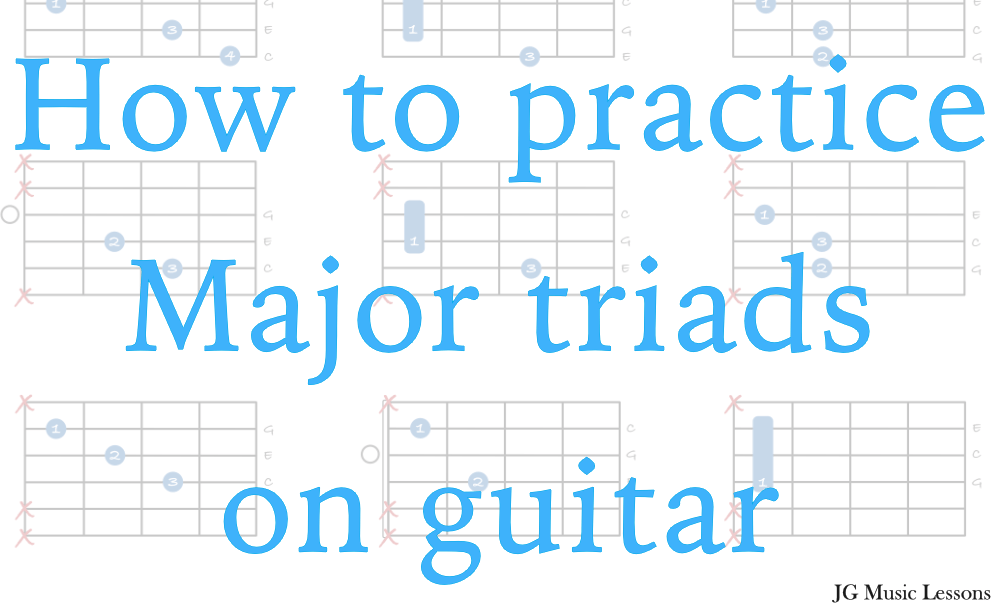In music, triads are the foundational building blocks used to create chords. We can use triads to outline the sound of a chord which is useful for creating melodies and for improvisation.
Although the concept is seemingly simple, working out the triads on the guitar will go a long way for various musical applications.
This lesson will cover how to play Major triads on the guitar, the inversions starting on different strings, arpeggio shapes throughout the fretboard and pattern exercises to practice them.
Grab your guitar and let’s get started!
Major triad formula
A Major triad is a chord built on 3 notes using the chord tones 1, 3, and 5. For example, a C Major triad has the notes C, E, and G. The formula for a Major triad is 2 whole steps, then 1.5 whole steps. See the formula in the image below.

Major triads chart
With this formula in mind, here is chart of the 12 Major triad chords.
| Major triad chord | 1 | 3 | 5 |
|---|---|---|---|
| C Major triad | C | E | G |
| D Major triad | D | F# | A |
| E Major triad | E | G# | B |
| F Major triad | F | A | C |
| G Major triad | G | B | D |
| A Major triad | A | C# | E |
| B Major triad | B | D# | F# |
| Db Major triad | Db | F | Ab |
| Eb Major triad | Eb | G | Bb |
| Gb Major triad | Gb | Bb | Db |
| Ab Major triad | Ab | C | Eb |
| Bb Major triad | Bb | D | F |
Major triad shapes on different strings
The first step to learning Major triads is knowing the different ways to play it on one guitar string. We’ll use the C Major triad for these examples.
Major triads on the 6th string
Here are three ways you can play a C Major triad starting on the 6th string below.

Major triads on the 5th string
The three shapes starting on the 5th string look the same as the ones on the 6th string.

Major triads on the 4th string
The Major triad shapes starting on the 4th string look slightly different than the 6th and 5th string triad shapes.

Major triads on the 3rd string
The Major triad shapes starting on the 3rd string also have unique shapes that look different from the ones on the other strings.

All of these Major triad shapes can be applied to any root note on the same string. Make sure to adjust the fingerings whenever open strings are included.
Major triad inversions
After learning the Major triads starting on each string, the next step is to learn the chord inversions. In short, a chord inversion is when you play the chord start on different chord tones.
For example:
- Root position is when you on the root note in the bass (lowest note).
- 1st inversion is when you have the 3rd of the chord in the bass.
- 2nd inversion is when you have the 5th of the chord in the bass.
Here is what this looks like in music notation for a C Major triad.

Now let’s look at how to play a Major triad and it’s inversions starting on different strings below.

Major triads guitar chord charts
The following charts show you what the Major triads look like in chord form for each string.
Major triad chords on the 6th string

Major triad chords on the 5th string

Major triad chords on the 4th string

Major triad chords on the 3rd string

Again, when playing chord with open strings, make sure to adjust these fingerings to what is most comfortable for you.

Major triad arpeggios shapes
For the previous examples, we have been learning Major triads horizontally across one string. In this section, we’ll be looking at the vertical triad shapes throughout the fretboard. Again, we’ll be using the C Major triad for the following examples.
Arpeggio shape 1

Arpeggio shape 2

Arpeggio shape 3

Arpeggio shape 4

Arpeggio shape 5

Keep in mind that fingerings change whenever you have open strings included in a triad. Experiment with different fingerings to see what works best for you.
Connecting arpeggio shape – two octaves
Here is an example of how to connect the Major triad shapes throughout the fretboard. We’ll be using the E Major triad for this example.

Major triad exercises
The following exercises can be applied to any of the arpeggio shapes on the fretboard. Here are some pattern exercises over one area of the fretboard using the C Major triad.
3 note pattern
After playing three consecutive notes of a triad, repeat the pattern on the second to last note (C, E, G then E, G, C, etc…)

4 note pattern
After playing four consecutive notes of a triad, repeat the pattern on the second to last note (C, E, G, C then G, C, E, G, etc…)

Note skipping pattern
For this pattern, you skip one note of the triad then repeat the pattern on the chord tone below it (C, G, then E, C, etc…)

Connecting Major triad shapes on the fretboard
The following chart helps you to visualize what all the notes of a C Major triad look like if you incorporated all the strings. Ultimately, you will want to know as many variations for any given chord so that you comfortably move around the fretboard. The shapes apply to any Major chord but you have to shift the shapes to the root note accordingly.
The orange circles indicate all the root notes to serve as guides around the fretboard.

Once you see all of the triad notes on the fretboard, you may notice that some shapes are similar to basic chord shapes. By learning different ways of playing a Major chord, it will help you to visualize the triad notes much easier.
Guitar Major triads chart
Use the following chart to review the Major triad shapes on guitar in C Major starting on different strings.
Wrapping up
Triads are a simple but effective way to outline the harmony of a chord. We covered how to play Major triads starting on different strings, inversions, arpeggio shapes throughout the fretboard and pattern exercises to practice them.
To master Major triads on the guitar, try working out these exercises in different keys. This will help you connect musical ideas and and visualize the notes on fretboard.
To learn more, check out how to play minor triads, spread triad chords, or Major 7 arpeggios.
This lesson was a further study of: A simple guide on learning triads on guitar.
📘 Get the free guitar practice guide here!
All the best,
JG Music Lessons




